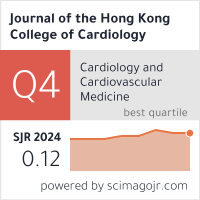Abstract
The first permanent pacemaker was implanted in Hong Kong in early seventies. Since then, the use of permanent pacing has steadily increased. The manufactures' sales figures were the only source of reference. In 1990, a Hong Kong Pacing Registry was set up, with the aim to establish a reliable source of pacemaker use in Hong Kong. Data were entered into a registry form during every permanent pacemaker implantation. The areas focused were: patient demographics (sex, age, symptomatology, associated medical illnesses and rhythm problems), pacemaker system characteristics (polarity, programmability and pacing mode) and implant procedure (site and route of entry and implant parameters). A total of 7767 forms were returned for years 1991-2002. There was a steady increase in the number of pacemaker implanted, with 77 and 125 per million population received their first implant in the year 1991 and 2002 respectively. Response rates to most individual items of the returned forms were over 90% (range 2.2-100%). The male: female ratio was 1:1.4. Dizziness (36.1%) and syncope (23.8%) were the main symptoms at presentation, and sick sinus syndrome (31.6%) and high grade heart block (37.3%) were the main rhythm indications for pacing. Significant proportion of the patients had associated medical diseases such as hypertension (24.4%) and ischaemic heart disease (13.3%). The relative frequencies of pacing modes used were: DDDR (34.2%), VVI (29.5%), VVIR (20.8%), DDD (10%), VDD(R) (2.5%) and AAIR (0.7%). The percentage of dual chamber pacemakers had increased from 27% in 1991 to 62% in 2002. Most pacemakers were implanted on the left side, with subclavian puncture technique being the usual procedure. In conclusion, these data from the Hong Kong Pacing Registry give a good account of the patient demographics and pacing practice in Hong Kong for years 1991-2002, which would be useful as a future source of reference. The registry has been updated to include data on new indications for pacing and implantable cardioverter defibilators.
Recommended Citation
Cardiac Pacing in Hong Kong: Second Report of the Hong Kong Pacing Registry Journal of the Hong Kong College of Cardiology 2003;11(3) https://doi.org/10.55503/2790-6744.1155
Creative Commons License

This work is licensed under a Creative Commons Attribution-Noncommercial-No Derivative Works 4.0 License.



